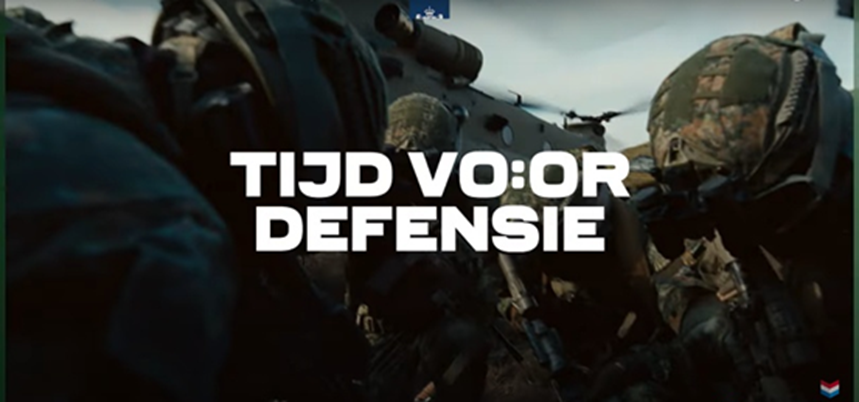Why I feel reassured, even in uncertain times
The world today? Let’s be honest – it feels increasingly unsettled. There’s war on Europe’s borders, rising digital threats, climate anxiety, and growing geopolitical tension. It’s a lot to take in. And frankly, the notion that safety was once a given now feels a little naive. Yet, in the middle of this turbulence, I find a sense of reassurance in how we, as a society, are starting to regroup. While worry is still part of my reality, I also sense a shift. A new kind of mindset is emerging. We're slowly preparing ourselves for a different era. Not through panic, but through awareness. Prepare yourself. Think about your role. Pack an emergency kit. Consider where you might be able to contribute in a crisis. And this shift? It's becoming especially clear in how Defence is now communicating with us.




A campaign that speaks to the times
The recent “Tijd voor Defensie” (Time for Defence) campaign by Dentsu Creative1 is a striking example. It landed at a moment when headlines are constantly reminding us how fragile our borders, infrastructure and digital networks really are. As I scroll through my phone or catch the evening news, I increasingly feel: this is about me too. Not because I’ll be signing up to the army tomorrow – but because new questions are being raised that we, as citizens, can and maybe should engage with. Time for Defence touches something fundamental. Not just with its powerful imagery and compelling slogans, but through what lies underneath: a clever blend of behavioural psychology and civic activation. Honestly? I find that impressive.
The visual language of urgency
The campaign uses a visual language that plays smartly on our perception of urgency and time pressure. What makes it so powerful is how ‘time’ is used both literally and symbolically. It’s not just telling you when to act – it’s a metaphor for why action is needed now. And unlike older campaigns that used fear, this one sparks a positive sense of urgency: it’s time to step up, time to make an impact. One particularly striking element is the typographic design of “VO:OR” – stylised like a digital clock. It’s a simple but brilliant choice. That ticking colon conveys a sense of countdown. This moment matters. And it’s echoed in lines like “These times call for you.” It feels like a personal call to action.

When research becomes activation
Beyond traditional advertising, Defence will soon roll out surveys2 aimed at potential recruits – not just to gather data, but as a form of active engagement. This, as a market researcher, is where my heart starts beating faster. It’s a non-conventional media move that does more than broaden the campaign, it deepens it. Original, bold, and right up my alley. Because here’s the thing: filling in a survey isn’t a neutral act. Behavioural research shows that something as simple as asking a question can already trigger change. Think of the Mere Measurement Effect (Morwitz, 1999): if you ask someone if they’re willing to do something, it makes them more likely to actually do it. Who knew research could double as a marketing tool?
Lessons from Sweden
Sweden has been working this way for a while through its Public Engagement Model3. Under Totalförsvaret (Total Defence)4, citizens are encouraged to take shared responsibility during crises through self-reliance, civic service, and volunteering. They understand that communication becomes more effective when the public feels personally involved. Instead of one-way messaging like traditional ads, surveys invite young people to express their views, and in doing so, reflect on their own stance towards Defence. This participatory communication builds more than just awareness, it builds empathy. Young people don’t just feel targeted; they feel seen. The survey becomes a mirror: “Could you contribute to national safety?” It’s a far more effective prompt than a slogan. It encourages self-reflection and taps into intrinsic motivation. And what do we see? When you take people seriously and invite their involvement, they feel more engaged and responsible. It's nudging, before nudging had a name, a soft push with a big impact. Techniques like the Foot-in-the-Door (Freedman & Fraser, 1966) and the Social Identity Theory (Tajfel &Turner, 1979) further reinforce this sense of belonging: small steps can lead to deeper engagement. By sending a survey, you’re implying: You’re already part of the Defence team.
What can we learn as researchers?
A great deal. Asking questions isn’t just about collecting data – it’s about influencing behaviour. A well-placed question at the right time can trigger a mindset shift. It’s something we can apply well beyond the military context. With Time for Defence, the Ministry is charting a new path. This platform is more than a recruitment campaign – it’s a rallying cry. Not just to guard borders, but to push boundaries. Young people are being offered the chance to realise their potential, something that’s not always a given in today’s world. That sense of being switched on –contributing to something greater than yourself – is at the core of this campaign. And maybe that’s what makes it so unique. It combines smart communication, behavioural insight, and social relevance. Time for Defence doesn’t feel like a campaign. It feels like awake-up call. For me? It’s a reassuring and empowering message in uncertain times.
About me
I work at Haystack Consulting, where we enthusiastically dive into everything related to strong communication. Sometimes we do that through a semiotic lens, but most of the time we go straight to the source: people. We gather insights through smart questions and sharp conversations —both qualitative and quantitative— to truly understand what moves, touches, and inspires them.
Notes:
- https://www.rijksoverheid.nl/documenten/videos/2025/03/28/campagne-tijd-voor-defensie
- https:/www.nu.nl/buitenland/6349970/defensie-wil-mogelijk-werven-met-zweeds-model-dit-moet-je-erover-weten.html)/Nos.nl/article/2560532-dutch-army-must-grow-much-larger-defence-will-grow-to-200-000-employees
- Public Engagement Model: Schalet, A., Tropp, L. R., & Troy, D. (2020). A Relational Model of Public Engagement. UMass Amherst.
- "Totalförsvaret" (Total Defence Totalförsvaret 2021-2025: Swedish Ministry of Defence. (2020). Main elements of the Government bill Totalförsvaret 2021-2025.).

Reach out to our expert on the matter









